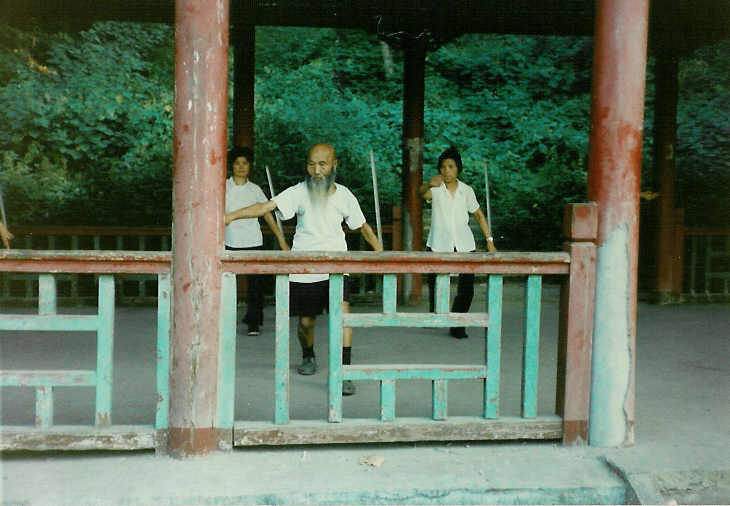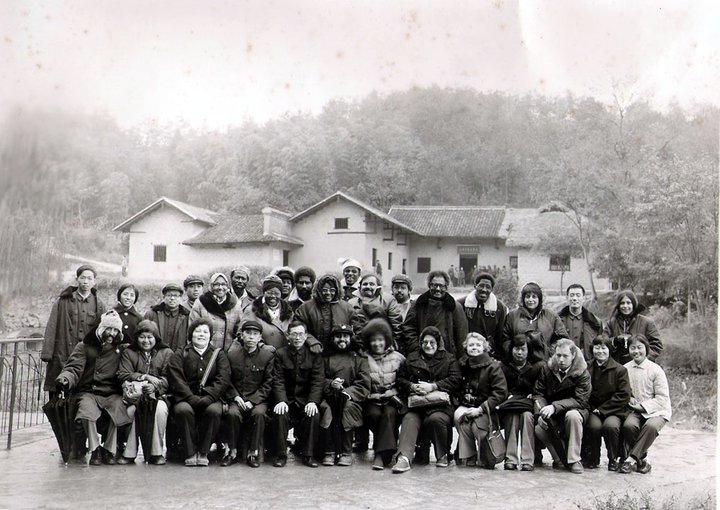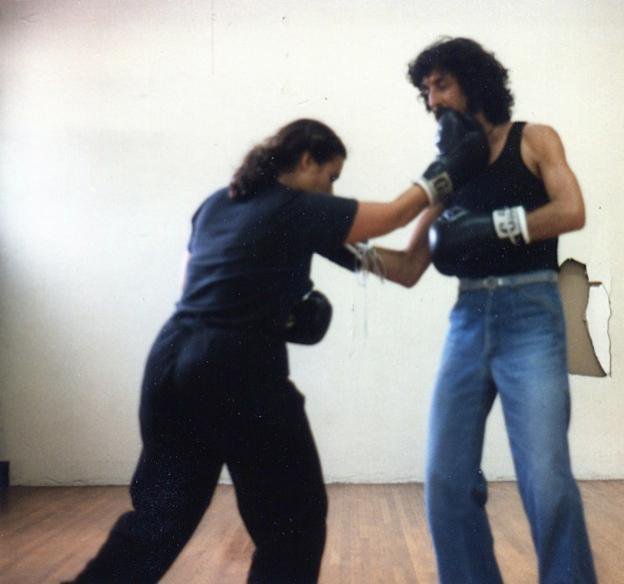Shéshān to Guăigùn: 91 year old Grandfather Dīng, "Dīng Yéye” and Snake Mountain Pavilion
/PART I: 91 YEAR OLD GRANDFATHER DĪNG, “DĪNG YÉYE” and SNAKE MOUNTAIN PAVILION
First glimpse of Dīng Yéye - before LaoMa had met him.
Since entering the world of Chinese Martial Art in 1964 I had a strong, constantly reoccurring dream of studying with a venerable, long white bearded Chinese Master of the martial arts, on a mountain, in a Temple somewhere in China. That dream came true in 1985, came true as real as I’m sitting here fingers pounding a tablet keyboard. Came true so close to the dream of it that though unable to believe in miracles, I definitely am convinced that you can have influence on your dreams actually making it through the mental realm into the material world of us mortal beings. This journey actually began a decade earlier.
Three years after President Nixon’s 1972 “opening” to the West of Mao Tse-Tung’s Mainland China’s isolation post-independence, I was invited with 21 other minority Americans to visit China. We were guests of the Cultural Revolutionary Regime and were to visit Chinese Minorities Peoples (54 separate peoples at that time, compared to our 3 major minority groups) across this ancient land. This bookmark in my life was of huge importance to me as I was able for the first time to visit and tour the newly awakened Sleeping Dragon. So, and more important to me, only five years after I began active training in Tàijíquán (太 極 拳) in America I was traveling all over China and able to join ordinary people every morning in public parks, village squares, and larger open spaces, in their daily early morning, communal Martial Art exercises, especially group Tàijí (太 極), a collective ritual we had been viewing on TV since, and long after, Nixon’s visit.
1975 at Mao’s Birthplace
After the impact of these unbelievable experiences, sponsored and made possible by Rick and Betsy Clemmons, my bosses in the Federal Drug Rehabilitation Program, Rubicon Door, where I worked, another quest was born: the dream to return to China, not to tour the country, but to live and work in one place, become part of a community, and train in the Wŭshù (武 術) of Tàijíquán. I could not conceive of how I would get back there, or what I would do for work if I could. But then...
A decade later in a serendipitous conversation with the brother of a Chinese friend I was given information and a referral to reach friends of his in Wŭhān, China , who would be able to help me realize my dream. And that’s how I was able to reach that quest and my “Dream Come True;” the real life altering experience that changed the course of the next 40 years of my life’s sojourn, and one small mosaic in that dream, the one leading directly to Lao Zhang and the Hooked Walking Stick Form.
Practice in front of Snake Mountain Pavilion
Unbelievably to me, 3 days after arriving in Wŭchāng, one of three cities making up the mega-city of Wŭhān which straddles the Yangtse River, a chance meeting in the street with a young music student, Chen Danbu, I was brought to the martial art playground on Snake Mountain (Shéshān, 蛇 山) and accepted into the school of 91 year old Dīng Hóng Kuaí, Dīng YéYe, “Grandfather Dīng,” (丁 爺 爺) the lineage holder of Táng Pài (唐 派), and a “National Treasure” of the Peoples’ Republic of China, an important fact of his life I was completely unaware of until years later when a student of mine found this important information on him in perusing the internet! He taught in the Snake Mountain Pavilion for 60 years, through war and social upheaval. The Pavilion is part of a memorial, along with a 25-30 ft. obelisk commemorating the 1911 Republican Revolution overthrowing the Qīng Dynasty, a rebellion started nearby in an Imperial Army barracks. Although the large rectangular Snake Mt. Pavilion was the only roofed structure, it was surrounded by scores of cleared areas claimed by different teachers and was a veritable Wŭshù Playground. The most beautiful site to train in martial arts imaginable.
Snake Mountain Pavilion
Along with the established teachers in these Folk Schools (Peoples’ Schools, not of the more visible Government “Wŭshù” Schools, though all are accountable to the government’s Physical Culture Institute), itinerant teachers would periodically sweep through the folk schools and teach Forms for a period of time before moving on to other playgrounds throughout the tri-cities of Wŭhān. One such teacher who appeared one day was 76 year old Lao Zhang who began teaching this exotic weapon: Guăigùn (枴 棍), the Hooked Walking Stick Form!
GLOSSARY OF Chinese Characters Used in the Text
Tàijíquán (太 極 拳). Great Ultimate Extremes Fist. Refers to Internal Martial Art
Tàijí (太 極). Great Ultimate Extremes. Refers to many endeavors other than Martial Art
Wŭshù (武 術). Chinese Martial Art (In Taiwan, the term used is Kuoshù)
Grandfather Dīng,” (丁 爺 爺)
Táng Pài (唐 派). Táng System of Martial Art, developed by the first Táng Emperor’s third son, Tangbi
Guăigùn (枴 棍). Hooked Walking Cane
Shéshān (蛇 山). Snake Mountain. Shān can refer to different sized mountains. We might not call the one in Wŭchāng a mountain but a hill, but in China they are all “shān”
Guăi (枴). Walking cane with hook
Gùn (棍). Stick or cudgel
Gùn zi (棍 子). Rod or stick
Guăi zhang (枴 杖). Walking stick
Jiàn (劍). Sword
Dāo (刀). Broadsword
Qínná (擒 拿). A twisting, grappling form of defense involving the capture and manipulation of the joints
Qì (氣). Vital energy, breath energy
Gōngbù (弓 步). Bow stance, the #1 stance of Tàijíquán
Máobĭ (毛 筆). Writing brush
Jīnshān (金 山). Gold Mountain (America). Mĕi Guó is the official name for America (“Beautiful Country”). Jīnshān is what many Chinese people call the U.S., perhaps traced to the California Gold Rush and/or building the Trans Continental Rail Road through the Rockies from the West Coast. Both events drew Chinese workers in large numbers to the U.S.
blackbamboopavilion@gmail.com
http://www.blackbamboopavilion.com/










